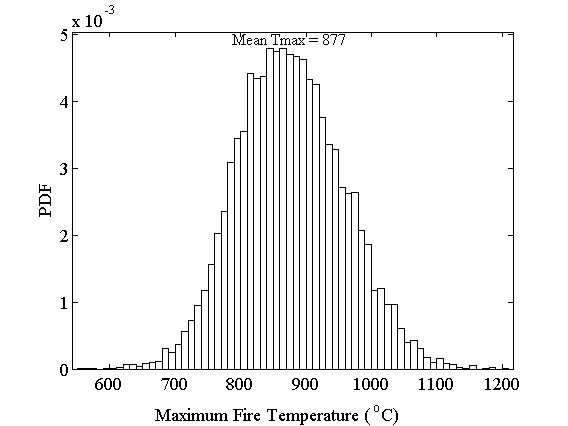
Fire is a particularly dangerous event not only because the structural response is not fully understood, but also because it may be a primary or secondary event caused by many other hazards (e.g. earthquake, blast). The fire safety design of buildings is typically the responsibility of the architect, not the engineer. This fire design is commonly derived from standard thermal tests (not structural tests), the results of which are assembled in a catalogue-like document. The basis for fire design of steel structures is thus not based on building structural performance. The ultimate goal of our group’s work is to reduce unnecessary human and economic losses through more reliable prediction of steel building performance in fire conditions. In addition to deterministic approaches to fire design, we are developing tools for probabilistic approaches to fire design, which enables a measure of reliability and risk. A reliability performance-based approach uses a probability distribution for variables with uncertainties, such as material properties and fuel. This type of approach to fire design describes the predicted structural response in a way that enables stakeholders to make informed decisions.
Partial List of References
- Elhami Khorasani, N., Gernay, T., Garlock, M.E.M. (2017). “Data-Driven Probabilistic Post-Earthquake Fire Ignition Model for a Community”, Fire Safety Journal, Elsevier, Vol 94, pp. 33-44.
- Gernay, T., Elhami Khorasani, N., Garlock, M.E.M. (2018). “Fire fragility functions for steel frame buildings: Sensitivity analysis and reliability framework”, Fire Technology, Springer, p. 1-36.
- Elhami Khorasani, N., Garlock, M.E.M., Gardoni, P. (2016). “Probabilistic Performance-Based Evaluation of a Tall Steel Moment Resisting Frame under Fire Following Earthquake”. Jrnl of Structural Fire Engineering, Emerald Insight, Vol. 7 No. 3, pp. 193-216.
- Gernay, T., Elhami Khorasani, N., Garlock, M.E.M. (2016). “Fire fragility curves for steel buildings in a community context: a methodology.” Engineering Structures, Elsevier, Volume 113, 15 April, Pages 259–276.
- Elhami Khorasani, N., Garlock, M.E.M., Quiel, S. (2015). “Modeling Steel Structures in OpenSees: Enhancements for Fire and Multi-Hazard Probabilistic Analyses“, Computers and Structures, Elsevier, Vol. 157, p. 218–231.
- Elhami Khorasani, N., Gardoni, P., Garlock, M.E.M. (2015). “Probabilistic Fire Analysis: Material Models and Evaluation of Steel Structural Members“, Journal of Structural Engineering, ASCE.
- Elhami Khorasani, N., Garlock, M.E.M., Gardoni, P. (2014). “Reliability-Based Approach for Evaluation of Buildings under Post-Earthquake Fires”, Proceedings of the 7th International Conference on Structures in Fire, Shanghai, China, June 11-13.
- Elhami Khorasani, N., Garlock, M.E.M., Gardoni, P. (2013). “Fire Load: Survey Data, Recent Standards, and Probabilistic Models for Office Buildings”, Engineering Structures, Elsevier, Volume 58, pp 152–165.
- Kodur, V.K., Garlock, M.E.M., Iwankiw, N. (2012). “Structures in Fire: State-of-the-Art, Research and Training Needs“, Fire Technology, Springer Journals, Volume 48, Issue 4, pp 825-839.
